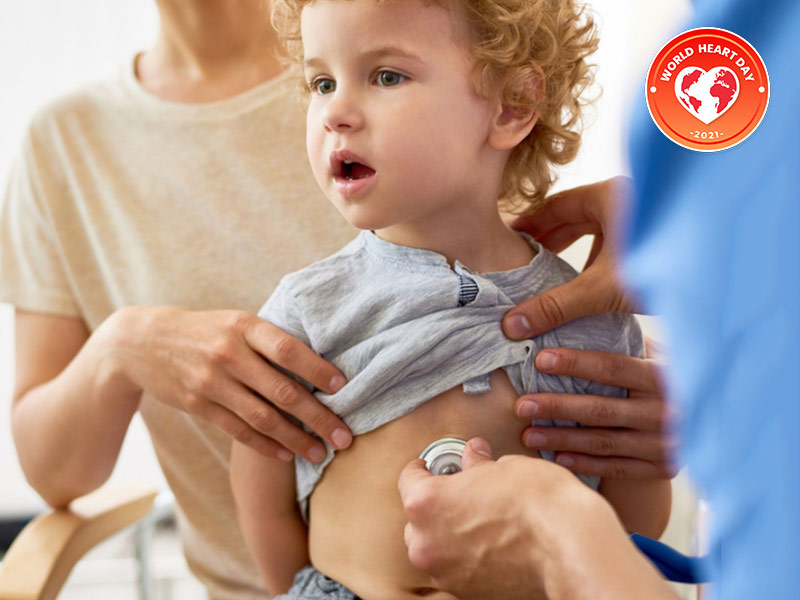
Heart disease is on the rise worldwide, and one of the main reasons for this is changing lifestyles. Every year, the 29th of September is designated as "World Heart Day" to address and showcase awareness about the importance of heart health. According to a study by World Health Organization (WHO), India has 17.7 million fatalities attributable to heart disease. A significant portion of the population is younger, so it is critical to be aware of congenital heart disorders (CHD) among youngsters.
Table of Content:-
The phrase "congenital" refers to something present from birth. One of the most frequent congenital disabilities is congenital heart disease, a group of diseases that affects the way the heart develops and works from birth and can modify the way blood flows through a person's heart. They could have cyanotic CHD (pink newborns) or cyanotic CHD (blue babies). On the occasion of World Heart Day 2021, Onlymyhealth talked to Dr. Nischal R. Pandya, Consultant – Paediatric and Adult Cardio Vascular Thoracic Surgeon, Fortis Hospitals, Bannerghatta Road, about congenital heart disease in children.
FAQs on congenital heart disease in children
A recent study stated more than 2,00,000 children in India are born each year with congenital heart disease, with one-fifth of those in a critical condition requiring surgery within a year of birth. The following are some of the frequently asked questions about CHDs:
1. What are the signs and symptoms of CHD in kids?

Image source: Americasbestcareplus
CHD can cause a variety of symptoms, particularly in children. The following are some of the most common signs and symptoms of congenital heart disease in children:
• Respiratory tract infections regularly
• Swelling of the legs, tummy, or around the eyes
• Fatigue
• Cyanosis (bluish discoloration of the skin, nails, lips, and tongue)
• Fast breathing/easy fatiguability while feeding
• Inability or limited ability to exercise or play (compared to peers of same age group)
Also read: Congenital Heart Diseases Is The Most Frequently Occurring Congenital Disorder, Study Says
2. What are the elements that may raise a child's chance of having CHD?
The majority of CHD difficulties arise before birth when a child's heart is still developing. Even though the specific origin of CHDs is unknown, various risk factors may play a role:
- Smoking and drinking alcohol while pregnant
- Taking certain drugs while pregnant
- Having diabetes
- Having Rubella (German measles) during pregnancy
- Smelling or consuming dangerous substances while pregnant
- Factors/syndromes of genetic origin
3. What is the treatment for Coronary Heart Disease (CHD)?

Image source: familydoctor.org
Congenital cardiac abnormalities can currently be diagnosed and treated using a variety of therapy techniques. Medicines, catheter treatments, and surgery are used to treat and cure a variety of ailments. Some defects necessitate several stages of operations, while others necessitate staged palliative procedures.
According to a report presented by the Centers for Disease Control and Prevention (CDC), around 97 percent of kids born with a non-critical CHD will live to be one year old, and approximately 95 percent of newborns born with a non-critical CHD will live to be 18 years old. However, these youngsters must be followed up on frequently.
4. Is it possible to detect these flaws during pregnancy?
Yes, an anomaly scan/foetal echocardiogram performed at 18-20 weeks of pregnancy (5th month of pregnancy) aids in detecting and diagnosing heart problems while the kid is still in the mother's womb. This is critical information that aids the treatment team and parents in determining the best course of action for these defects in the future. Because some infants may require surgery soon after birth, the delivery must occur in a facility that offers pediatric cardiac services (pediatric cardiology and pediatric heart surgery) as a backup.
Also read: 7 Symptoms of Congenital Heart Disease
5. Is COVID-19 more likely to impact children with heart disease?
Children with CHD or CHD after surgery are known to have an increased risk of developing severe disease. It is crucial to implement precautions to avoid infection and treat respiratory infections as soon as possible.
6. What can be done to protect children with congenital cardiac disease from COVID-19?
Masking, social distancing, and excellent hand hygiene are all essential strategies to take. Regular physical examinations and teleconsultations with your doctor can be beneficial. It is always recommended that you pay a visit to your doctor before having your child vaccinated and that you complete your child's immunizations according to the schedule.
As a result, these congenital cardiac problems must be detected early on. It is important to discuss treatment choices with a multidisciplinary team and plan out operations appropriately for a successful and healthy outcome.
Image credits: Texaschildren.org
Also watch this video
Read Next
What Is Serous Otitis Media? How It Is Different From Ear Infection, Know Symptoms And Risk Factors
How we keep this article up to date:
We work with experts and keep a close eye on the latest in health and wellness. Whenever there is a new research or helpful information, we update our articles with accurate and useful advice.
Current Version